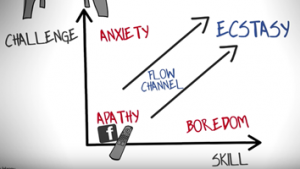Have you ever been so focused on an activity that you lost track of time? I often lose track of time when I’m writing or playing piano. Researchers have shown that performers often experience flow including rock stars, jazz musicians, and gold medal athletes.
Everyone can experience flow, and it can occur anywhere whether at work or engaged in a hobby. The key is experiencing enough challenge without feeling overwhelmed.
According to Mihaly Csikszentmihalyi, the father of flow theory, when we experience flow we:
- Are fully immersed in a task
- Hit a sweet spot balancing the challenge and our skill level
- Feel that time speeding up or slowing down
- Experience a sense of effortlessness
- Feel satisfied at mastering a skill
- Experience a merger of being and doing
FightMediocrity’s 5-minute video does a great job summarizing Csikszentmihalyi’s flow theory. The chart below explains how you may feel when a task is too challenging, too easy, or just right:

In educational theory, Vygotsky’s scaffolding theory and “zone of proximal development” are related to flow. According to Vygotsky, learning some content requires assistance from a teacher or expert. Students get in the “zone” and feel stretched when they are working with faculty and peers who have more skill and knowledge.
Getting back into the flow of college coursework at the beginning of a semester can be challenging. Fortunately, there are steps you can take to start flowing:
1. Eliminate distractions. Put away your cell phone and turn off alerts on your laptop. Find your favorite place to study at the Park Library.
2. Have a study strategy. Review class notes immediately after class or an hour before the next class session. Chunk your studying. Begin by studying course material you enjoy or find interesting then switch to more challenging content.
3. Practice frequently. Practice both existing skills and new skills. Skill-building is like climbing a ladder. With each step, you reach new heights. New skills build upon those you already have mastered.
4. Study with a group of students. Students who study together enjoy the flow experience more than those who study alone. If you’re not convinced, ask someone who participates in intramural or varsity team sports, a music ensemble, or the Baja racing team.
5. Be patient. Persistence is important. Don’t give up before your breakthrough happens. When I broke my wrist a few years ago, I was very impatient during my occupational therapy sessions. I didn’t gain strength and flexibility as quickly as I expected. However, I could see progress when I compared my current abilities with my abilities three weeks prior.
6. Schedule an appointment with a success coach. They can teach you strategies to help you reach your goals.
7. Major in a subject you love. You are more likely to experience flow when you are passionate about your coursework.
Want to learn more? Visit CMU Libraries in person or online to:
- Check out a book written by Csikszentmihalyi:
- Read an e-book about Vygotsky’s theory:
- Introduction to Vygotsky by Harry Daniels
- Vygotsky in Perspective by Ronald Miller
- Vygotsky’s Legacy by Margaret E. Gredler and Carolyn Claytor Shields
- Watch a streaming video:
- Flow: Psychology, Creativity, and Optimal Experience (60 minutes)
- Vygotsky’s Developmental Theory: An Introduction (29 minutes)
